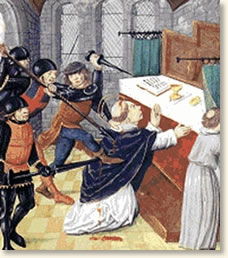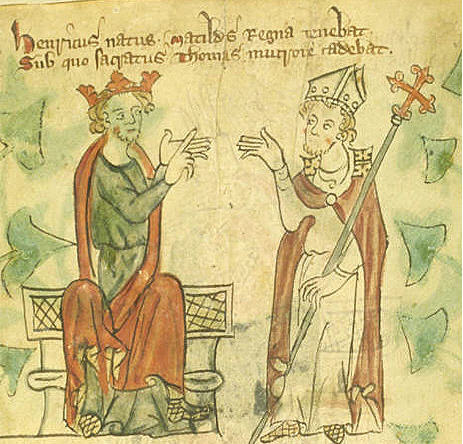I had on an itchy wool sweater the other day that practically drove me bonkers. It got me thinking about how pious people in the Middle Ages wore hair shirts–usually a linen chemise lined on the inside with itchy, bristly horsehair–to atone for their sins and to mortify their flesh. As an added tormenting bonus, the shirts often became riddled with pesky bugs. Wearing such a shirt must have been deeply unpleasant. One of the most famous wearers of a hair shirt was Thomas à Becket (1118 – 1170).
Becket began wearing a hair shirt soon after he was appointed Archbishop of Canterbury. Perhaps his new clerical position made him feel a sudden urge to mortify his flesh. Perhaps he took to wearing this extremely uncomfortable garment out of remorse for the fun he’d had as the youthful companion to his old friend, King Henry II. Thomas’s change of attitude from party-boy to altar-boy dismayed the king, to say the least, and their friendship strained to the breaking point. Besides wearing the haircloth, Becket became a vegetarian (during a time when vegetables were reviled by the well-to-do). To top off his extreme virtuousness, every night Becket washed the feet of thirteen beggars.
Unfortunately Becket’s newfound piousness made him a lot of enemies among the nobility. In 1170 he was set upon by several armed noblemen and hacked to death at the altar of the cathedral in Canterbury.
 The dead archbishop was found to be wearing layer upon layer of clothing. Working from the outer layers inward, he had on a brown mantle, white surplice, fur coat of lambs’ wool, two woolen pelisses, a black cowled Benedictine robe, a shirt, and underneath it all, a linen chemise lined with itchy horse hair. This tormenting garment was riddled with biting insects. When the bugs that had been infesting the archbishop were exposed to the cold air, the hairshirt, in the words of one chronicler, “boiled over with them like water in a simmering caldron.”
The dead archbishop was found to be wearing layer upon layer of clothing. Working from the outer layers inward, he had on a brown mantle, white surplice, fur coat of lambs’ wool, two woolen pelisses, a black cowled Benedictine robe, a shirt, and underneath it all, a linen chemise lined with itchy horse hair. This tormenting garment was riddled with biting insects. When the bugs that had been infesting the archbishop were exposed to the cold air, the hairshirt, in the words of one chronicler, “boiled over with them like water in a simmering caldron.”
Members of the public were outraged by Becket’s murder, especially as the king was suspected of having had something to do with it. Stemming from what may have been true remorse, but also to atone publicly for any involvement he may have had in his ex -friend’s murder, King Henry promised the pope he would perform any penance required. The pope duly ordered the king to set forth on a long and arduous journey to Canterbury on foot. The weary monarch limped the last three miles into Canterbury on bare and bleeding feet.
As further penance, the king was assigned to wear Becket’s bug-ridden hair shirt.
